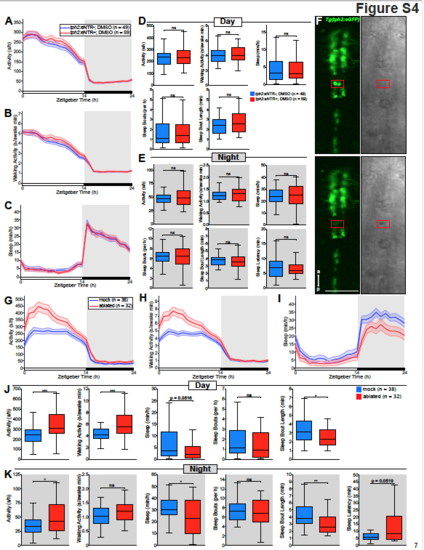Fig. S4
|
Vehicle treatment of Tg(tph2:eNTR-YFP) animals does not affect behavior; 2-photon laser ablation of the raphe results in increased locomotor activity and decreased sleep in zebrafish, related to Figure 3. (A-C) Activity (A), waking activity (B), and sleep (C) for Tg(tph2:eNTR-YFP) (red) and non-transgenic sibling control (blue) zebrafish treated with DMSO. Line and shading represent mean ± s.e.m. (D and E) Boxplots quantifying activity, waking activity, sleep, sleep bout number, sleep bout length during day (D) and night (E) and sleep latency during night (E). (F) Top: Image of Tg(tph2:eGFP) fish (green channel on left, transmitted light image on right) before ablation of cells in red box. Bottom: Same as above but after 2-photon laser ablation; note small cavitation in transmitted light image (red box). The same process was repeated until all GFP+ cells in the shown area were ablated. Scale bar, 50 μm; a, anterior; p, posterior. (G-I) Activity (G), waking activity (H), and sleep (I) for raphe laser-ablated (red) and mock laser-ablated sibling . control (blue) zebrafish. Line and shading represent mean ± s.e.m. (J and K) Boxplots quantifying activity, waking activity, sleep, sleep bout number, sleep bout length during day (J) and night (K) and sleep latency during night (K). n = number of animals. ns p>0.05, *p<0.05, **p<0.01, ***p<0.001, Mann-Whitney test |

